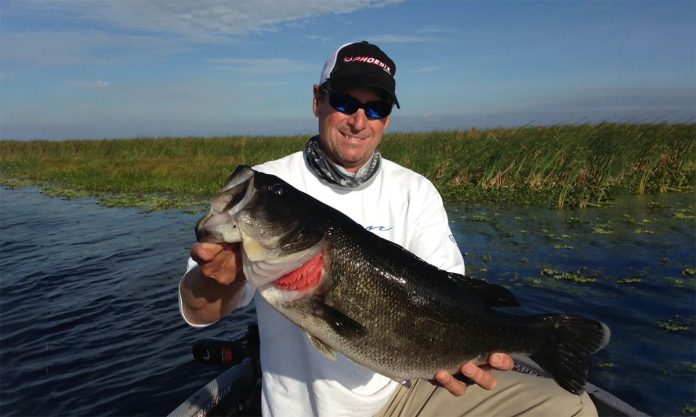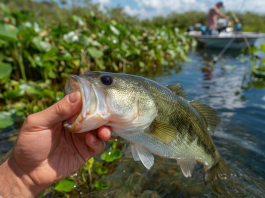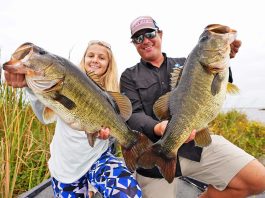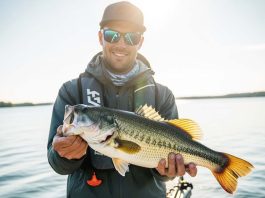There are legendary bass lakes, and then there’s Lake Okeechobee. Sprawled across the heart of South Florida, The Big O isn’t just a spot on the map; it’s a living, breathing cathedral of bass fishing. For generations of anglers, a trip here is a pilgrimage. This massive, 730-square-mile body of water is a true natural wonder, a ‘liquid prairie’ of vegetation and life that grows some of the biggest and most aggressive largemouth bass on the planet. This is the definitive guide to Lake Okeechobee bass fishing, built to cut through the noise and give you the real-deal knowledge you need to tangle with a trophy.
Forget everything you think you know about traditional lake fishing. The Big O operates by its own set of rules. It’s shallow, it’s wild, and it can be incredibly intimidating. But with the right approach, it’s also the most rewarding fishery you will ever experience. We’re going to break down the seasonal patterns, dissect the lake section by section, and build your perfect Okeechobee tackle box. This is your blueprint for success.
Understanding The Big O: More Than Just a Big Lake
To really succeed on Okeechobee, you have to understand its personality. Its sheer size is the first thing that hits you. At over 30 miles across, you can easily be out of sight of land, making it feel more like an inland sea than a lake. This isn’t a place you just show up and start casting. A good GPS is essential for safe navigation.
The lake is shaped like a shallow saucer, with an average depth of only about nine feet. This shallow nature is what makes it so fertile. Sunlight penetrates to the bottom across vast areas, creating an explosion of aquatic vegetation. This isn’t just ‘weeds’; it’s the entire habitat. Fields of hydrilla, eelgrass, and peppergrass form underwater forests where bass live, hunt, and spawn. The perimeter of the lake is lined with dense bulrushes, cattails, and Kissimmee grass, which provide critical spawning and ambush cover.
A massive earthen structure, the Herbert Hoover Dike, surrounds almost the entire lake. This dike, managed by the U.S. Army Corps of Engineers, is used to control water levels for flood prevention and water supply. For anglers, this is one of the most critical factors to watch. Fluctuating water levels dramatically change the fishery. High water pushes bass deep into the impenetrable reed lines, scattering them. Low water pulls them out to the edges of the grass, concentrating them and making them easier to target. Always check the current lake stage before you head out.
Seasonal Breakdown: Timing Your Okeechobee Trip
While you can catch bass on Okeechobee year-round, there is without a doubt a prime time. The action builds through the fall and peaks in a spectacular way from winter through spring. Understanding this cycle is the first step toward a successful trip.

The Prime Time: Winter & Spring Spawn (November – April)
This is what the reputation of Lake Okeechobee bass fishing is built on. As cooler weather settles in, giant schools of bass begin a steady migration from their summer haunts toward their shallow spawning grounds. This is a months-long process, offering several distinct phases of incredible fishing.
Pre-Spawn (November – January): This is the kickoff. As water temperatures drop into the low 70s and 60s, the bass start to get serious about feeding. They stage on the first available pieces of cover outside the main spawning flats. Look for isolated clumps of reeds, submerged hydrilla points, and ditches leading into the shallows. This is the time for moving baits. A lipless crankbait, like a Bill Lewis Rat-L-Trap in a chrome or crawfish pattern, is deadly. Ripping it through the grass to trigger reaction strikes is a classic Okeechobee pattern. Vibrating jigs and slow-rolled spinnerbaits are also fantastic choices to cover water and find these aggressive, staging fish.
The Spawn (February – March): This is the main event. When the water temperature is stable in the mid-60s, the big females move in. They will fan out ‘beds’ or nests in sandy or hard-bottom patches, often right next to a piece of cover like a reed clump or a submerged log. This is when shallow water becomes the entire focus. Anglers will patrol vast flats of reeds and hydrilla in 1-4 feet of water, looking for the tell-tale light-colored patches on the bottom. High-quality polarized sunglasses are not optional; they are mandatory equipment. Baits for bedding bass should be slow-moving and aggravating. A wacky-rigged stick worm, a Texas-rigged lizard, or a creature bait in white, green pumpkin, or black/blue are all you need to coax a bite from a territorial female. Patience is key.
Post-Spawn (April – May): The spawn winds down, but the fishing does not. The females move out to the nearest cover to recover and feed, while the smaller males stay behind to guard the newly hatched fry. These ‘fry guarders’ are extremely aggressive. You’ll often see them chasing away bluegills from a dark cloud of tiny bass fry. A swim jig or a topwater popper worked near the fry ball is almost guaranteed to get crushed. This is also when the topwater frog bite really begins to catch fire as the mats of hydrilla thicken up.
The ‘Other’ Seasons: Summer & Fall (June – October)
Many anglers pack it in when the heat arrives, but that’s a mistake. The fishing changes, but it can still be phenomenal if you adapt your strategy.
Summer (June – August): Florida heat is no joke, and the bass feel it too. The key is finding cooler, more oxygenated water. This means two things: early/late, or deep in the thickest cover. The first and last hour of daylight can offer an explosive topwater bite with walking baits and frogs along the outside grass lines. Once the sun gets high, the game changes to punching. Bass will retreat under the thickest canopies of matted hydrilla and hyacinths. This vegetation provides shade and cooler water temperatures. Punching a 1- to 2-ounce tungsten weight with a compact creature bait through that mat to get to the fish below is the most productive pattern.
Fall (September – October): This is the great transition. As days shorten and the first cool fronts arrive, the water begins to cool from its summer peak. The bass sense the change and know winter is coming. They begin to feed heavily, often chasing massive schools of shad around the open parts of the lake. Finding the bait is everything. Look for diving birds. A white spinnerbait or a rattling lipless crankbait can be the ticket to loading the boat when you find a school of feeding bass.
Where to Fish: Breaking Down The Big O
With 730 square miles of water, the most common question is simply, ‘Where do I start?’ The lake can be broken down into four general zones, each with its own character. Your choice will often depend on wind direction and current water levels.
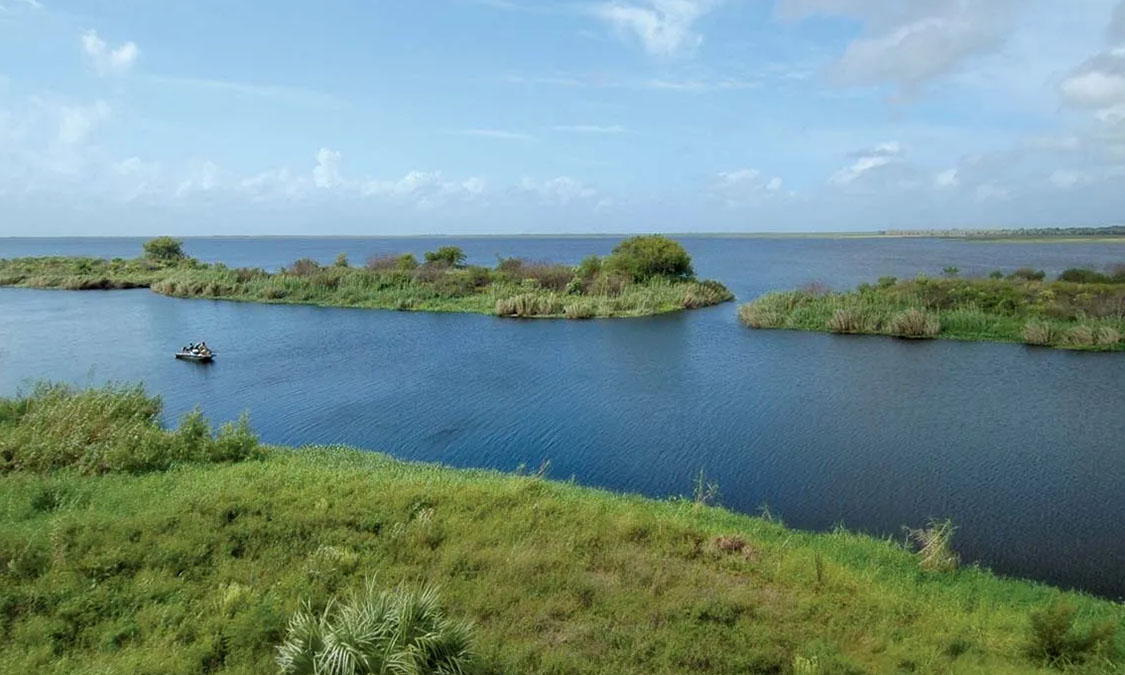
The North Shore (Clewiston & Lakeport)
This is arguably the most famous stretch of water, home to the legendary Roland Martin Marina and a hub of tournament activity. The area from Indian Prairie to Horse Island is a maze of reeds, cattails, and canals. Fisheating Creek enters the lake here, creating vital current and a constant source of nutrients. This area is a flipping and pitching paradise, especially during the spring spawn when bass push into the endless fields of reeds. It offers some protection from a strong south wind.
The South End (Belle Glade & South Bay)
The south end is famous for its vast, shallow flats known as the ‘hayfields.’ This is where you’ll find enormous fields of submerged hydrilla, peppergrass, and eelgrass. When the water is right, this is a phenomenal area for fishing moving baits like vibrating jigs and lipless cranks over the top of the grass. The area around Rita Island and Pelican Bay is a primary spawning ground and a top destination for anglers looking to punch thick mats during the summer months. It’s very exposed, so it can get rough in a north wind.
The East Side (Port Mayaca & Canal Point)
The east wall, near the Port Mayaca lock and J&S Fish Camp, offers a different flavor. Here you’ll find more defined reed lines mixed with rocky structure along the rim canal. The water is often a bit clearer on this side. It’s a great area to target with jerkbaits in the pre-spawn and topwater lures along the outside reed heads. The cuts and locks create current, which can be a magnet for bait and bass, especially on calm, sunny days.
The West Side (Moore Haven)
The west side is characterized by numerous man-made spoil islands and the main channel of the Kissimmee River entering the lake. These spoil islands create excellent structure and current breaks. Pitching jigs to the rocky corners of these islands can be very productive. The outside grass beds here are often the first to heat up during the pre-spawn, as they get plenty of sun and have quick access to deep water in the nearby canal.
The Okeechobee Arsenal: Lures and Techniques
You don’t need a boat full of tackle for Okeechobee. A handful of specific lure types, presented with the right technique, will account for 90% of the fish caught. This is about mastering the fundamentals.
[INTERNAL LINK: A detailed guide to Punching Heavy Mats for Florida Bass]
Flipping, Pitching, and Punching
This is the heart and soul of Okeechobee fishing. It’s close-quarters combat in heavy cover. Your gear needs to be up to the task: a 7’6″ to 8′ heavy or extra-heavy action rod, a high-speed baitcasting reel (8:1 ratio or faster), and 65-pound braided line. No exceptions. You need the power to haul a giant out of thick grass and the speed to get it out quickly.
- Flipping & Pitching: Best for targeting visible cover like reed clumps and cattail patches. A 1/2 to 3/4-ounce Texas-rigged creature bait, craw, or big worm is standard. Top colors are always Black/Blue, Junebug, and some form of Watermelon/Green Pumpkin.
- Punching: This is for the thickest, nastiest matted vegetation you can find. Here, you’ll need a much heavier tungsten weight (1 to 2 ounces) to break through the canopy. Use a compact creature bait and a specialized ‘punch skirt’ to create a bulky profile. The bite is often just a subtle ‘tick’ or a mushy feeling as the fish swims off with it. Reel down and hit it hard.
Vibrating Jig (The ‘Chatterbait’)
If one lure has dominated Okeechobee over the last decade, this is it. A vibrating jig is part jig, part spinnerbait, and 100% effective. The thumping vibration calls fish out of the grass, and its relative weedlessness allows you to fish it in places you can’t throw a crankbait. Use a 1/2-ounce model in colors like black/blue, white, or green pumpkin. A swimbait-style trailer is key to giving it the right action. Simply cast it out and reel it steadily, occasionally popping it free when it snags on grass.
Topwater Warfare
There’s nothing more exciting than a Big O bass blowing up on a topwater lure. This is a primary pattern in the early mornings, late evenings, and on overcast days, especially from post-spawn through fall.
- Hollow-Body Frog: Essential for fishing over the top of matted grass. Use a walking-style frog for open pockets and a popping-style frog for making a commotion to draw fish up through the mat. Work it slowly, with lots of pauses.
- Walking Baits: Lures like the Zara Spook are perfect for the edges of grass lines and around open-water cover. The ‘walk-the-dog’ retrieve is irresistible to schooling fish.
- Buzzbait: A great choice for covering water quickly along reed walls and sparse grass. The commotion often triggers incredible reaction strikes.
Moving Baits for Staging Fish
During the pre-spawn and fall, when fish are actively feeding but not locked into one spot, moving baits are your best friend. A lipless crankbait ripped through submerged peppergrass and hydrilla is a classic technique. A swim jig is a more subtle approach and can be deadly on pressured fish. Cast it into the same places you would flip, but swim it back slowly through the cover.
[INTERNAL LINK: Top 5 Must-Have Lures for Lake Okeechobee]
Pro Tips and Local Knowledge
Ready to fish like a local? These are the little things that make a huge difference.
- Watch the Water Level: We said it before, and we’ll say it again. It’s everything. Check the official data from the South Florida Water Management District (DBHYDRO) or the FWC. The ideal level is generally considered to be between 12.5 and 15.5 feet.
- Wind is Your Friend: Don’t fear the wind. While the main lake can become dangerously rough, a steady 10-15 mph wind is a good thing. It positions baitfish, creates current, breaks up the surface to make fish less spooky, and helps you drift across large flats. Always have a plan to fish in an area protected from the day’s wind direction.
- Find Clean Water and Green Grass: ‘Clean’ on Okeechobee doesn’t mean clear. It means water that isn’t muddy or choked with brown, decaying vegetation. Look for healthy, vibrant green hydrilla. That’s where the oxygen and the bait are, and the bass will be right there with them.
- Tournament Pressure is Real: The Big O is home to countless tournaments, including the prestigious Bassmaster Elite Series. This pressure educates the fish. If you’re fishing after a big event, try showing the fish a different look. Use a more subtle color, a smaller bait, or fish a less-obvious piece of cover that others may have overlooked.
- Hire a Guide: For your first one or two trips, hiring a reputable local guide is the best investment you can make. The cost of a guide is far less than the time and money you’d waste trying to figure out this massive, complex lake on your own. They will teach you navigation, current patterns, and the specific techniques that are working right now.
Lake Okeechobee is a true jewel of the bass fishing world. It’s a challenging, dynamic, and sometimes unforgiving environment. But it is also a place of giants, a lake where every flip into a reed head could be the fish of a lifetime. Respect the lake, do your homework, and prepare for a battle. The Big O is waiting.
